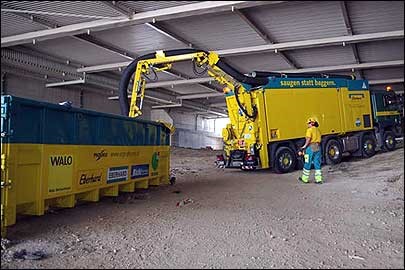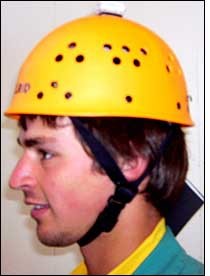Projektdetails
-------------------------------------------------------------------------------------------------------------------------------------
|
At Former Landfill, RFID Monitors Workers and Waste |
As contaminated soil and hazardous refuse are removed from the site, a location-tracking system ensures that workers can be rapidly evacuated during emergencies, and that containers of waste are properly routed.
By Brett Neely
July 25, 2008—Sondermülldeponie Kölliken (SMDK), a hazardous waste landfill in Kölliken, Switzerland, has adopted an ultra-wideband (UWB) location-tracking RFID system that can pinpoint employees and containers within its contaminated areas (known within the industry as "black areas"). The landfill is in the midst of a multiyear decommissioning program that will remove 545,000 tons of waste and ground cover from the site, located approximately 50 kilometers (31 miles) west of Zurich. Between 1978 and 1985, the site served as the repository for waste of "many different kinds and compositions," according to SMDK's Web site.
When the local government discovered that chemicals at the landfill site were leaching into the groundwater and threatening the drinking water, it ordered the complete dismantling of the landfill. The decommissioning is currently being carried out by a consortium known as ARGE Phoenix, and the waste removal is scheduled for completion by the end of 2012.
 |
|
A dredger deposits contaminated soil in RFID-tagged containers. |
The project calls for the construction of a building covering the entire landfill. As contaminated materials are removed, the air pressure within the work area is kept low, to prevent the escape of dust, gas and odors. The first phase of the ultra-wideband system took three months from conception to implementation, according to Thomas Kersten, a project manager with the endeavor's prime contractor, ESG, a German company specializing in IT systems integration.
The site's regulators required escape routes for all workers within the "black" areas, which cover slightly more than 50 percent of the 7-hectare site. The original decommissioning plan called for escape tunnels, but these proved impractical for both engineering and cost reasons. "So one guy said, 'Maybe it's enough if we can track every employee on the site,'" says Bruno Becker, marketing manager for Ubisense, which manufactures the UWB sensors (readers) and battery-powered tags used at SMDK. "It's really the first project of this sort."
The tracking system enables SMDK's management to know the precise whereabouts of all workers within the site's "black" areas so it can maintain a precise head count in case of a fire or other emergency, and rescue any employees having difficulty evacuating to safety. To date, SMDK has not experienced any emergencies since implementing the system.
Using the same UWB technology, SMDK has also deployed a waste container tracking system. As containers filled with contaminated dirt depart the facility, interrogators scan each container's tag and verify whether it is the proper container headed for the correct destination.
The tags are attached atop workers' helmets, as well as to the waste containers. According to Ubisense's Becker, the tracking system provided by Ubisense and ESG allows both employees and containers to be tracked to an accuracy of 30 centimeters (12 inches). The tags operate on the 6 to 8 GHz spectrum and utilize a proprietary air-interface protocol.
The tags communicate with readers approximately two to three times per second; they could transmit up to 20 times per second, though they don't in order to conserve battery life. Because the system allows two-way tracking, it can also monitor the battery status of individual tags. The sensors are arranged into a pattern that divides the site into discrete cells, and the tags communicate with sensors associated with the particular cell they are in.
 |
|
An active RFID tag is mounted atop each worker's hard hat. |
The system is presently deployed across a portion of the site measuring approximately 8,000 square meters (86,000 square feet). The project is now entering its second phase, says Bruno Hausheer, a project manager for ARGE Phoenix, and is expected to expand to the entire contaminated "black" portion of the site—approximately 38,000 square meters (409,000 square feet)—by the start of 2009.
About 80 personnel tags and 100 container tags are currently in use at the Kölliken site, paired with about 40 readers. According to Becker, each tag costs approximately €60 to €70 ($94 to $110) and has a battery life of one to four years. Deploying the ultra-wideband system, he says, cost between €100,000 and €200,000 ($157,000 and $314,000).
At any particular time, Hausheer says, the system tracks between 10 and 20 employees simultaneously. The software also allows for the implementation of access rules—for instance, users can define access zones that will trigger alarms or event reporting if specified personnel enter areas to which they do not have access rights.
What's more, Kersten says, the location-based nature of the system also enables additional functionality. "The system could also tell you if a worker has gone through bad air," he states, "or whether they are having health problems and have fallen on the ground." Other industries with similar safety challenges, he adds—such as the chemical industry, or on oil rigs—could benefit from a similar solution as well.
Copyright © RFID Journal, Inc. All Rights Reserved
---------------------------------------------------------------------------------------------------------------------------------



